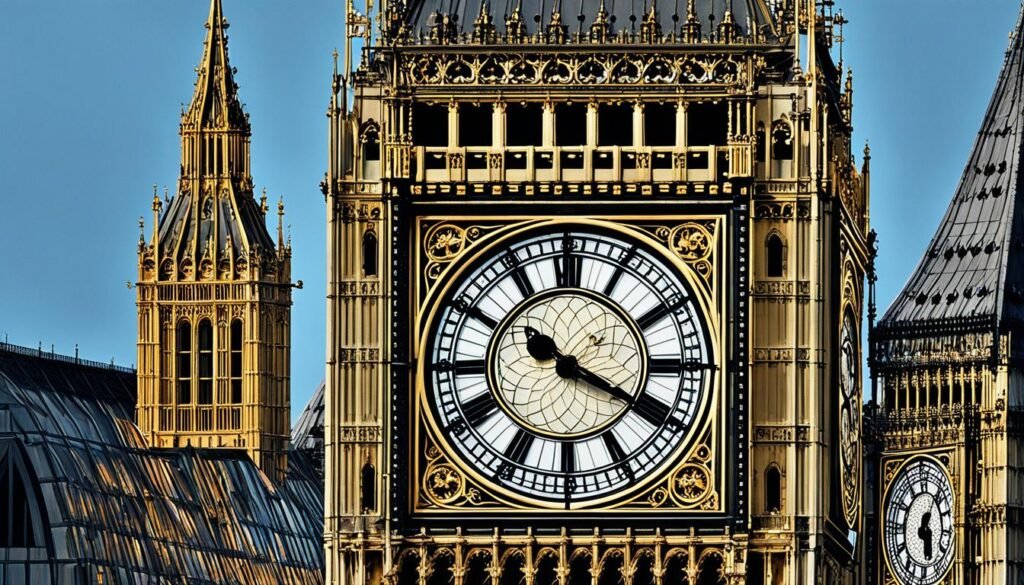Imagine being at the heart of London, feeling the city’s vibrant energy. You look up and see the magnificent Big Ben, an iconic London landmark over 150 years old. The Elizabeth Tower’s grandeur invites you to explore its history and stunning architecture.
Big Ben has stood as a symbol of London for centuries. It shows the city’s greatness and the spirit of its people. Its neoclassical and gothic design combine beautifully, showing timeless elegance.
Every part of Big Ben, like the detailed carvings and the incredible clock faces, shares a story. The London clock tower is more than a timekeeper. It’s a piece of the city’s history and culture.
Let’s uncover the rich history, stunning architecture, and hidden stories of Big Ben in Westminster, celebrating British architecture. Learn about the symbol of inspiration that’s loved worldwide for London’s timeless beauty.
The History and Construction of Big Ben
Big Ben is both a stunning building and a story of history and construction of its time. Unfortunately, the old tower faced a fire in 1834. This led to a competition to rebuild the Palace of Westminster. Architect Charles Barry won that competition.
Barry teamed up with Augustus Pugin to plan the new clock tower. Pugin was a key figure in the Gothic Revival movement. Together, they made Big Ben’s design a mix of neoclassical and Gothic styles.
This teamwork between Barry and Pugin created an iconic symbol of British architecture. The structure stands for centuries as a sign of the era’s grandeur and elegance.
“The collaboration between Barry and Pugin resulted in the creation of a truly iconic structure that would serve as a symbol of British architecture and national pride for centuries to come.”
Barry’s big ideas and Pugin’s focus on detail made Big Ben more than a clock tower. The tower’s careful design showed off the country’s power. It was a mark of prestige during the Victorian times.

Gothic Revival in the Design
Pugin’s work on Big Ben was crucial. He was a key person in the Gothic Revival movement. His designs, like ornate carvings and arches, made the tower special.
This use of Gothic style made Big Ben stand out. It also showed the UK’s deep cultural roots. Pugin’s skill mixing old looks with new building methods made Big Ben truly unique.
A Structure Built to Last
Building Big Ben started in 1843 and finished 13 years later. It’s 315 feet tall. This makes it a huge part of London’s look.
The base of the tower is a strong concrete slab. The rest of the tower is made of brick and covered in limestone. This keeps it strong against the weather.
 Neuschwanstein Castle: Bavaria’s Medieval Wonder
Neuschwanstein Castle: Bavaria’s Medieval Wonder
The designs and building methods Barry and Pugin used have stood the test of time. Big Ben keeps its place as a symbol of their great work and skill.
The Legacy of Big Ben
The story and making of Big Ben are key to London and the UK’s culture. It stands for the country’s heritage, strength, and new ideas.
Big Ben doesn’t just attract many people every year. Its beauty and story make visitors feel the weight of history and national pride. Big Ben tells the tale of a UK that has overcome many tests.
The Clock and its Mechanism
Big Ben’s clock is a true Victorian work of art. Edmund Beckett Denison, working with George Airy, created it. Denison’s innovative gravity escapement improved its accuracy, making it the best clock of the time.
The clock faces are massive, over 7 meters across. Using opal glass and gas lighting, they are visible from a distance. This choice was inspired, making the clock stand out even at night.
Thanks to Denison and Airy, Big Ben’s clock is not just large but incredibly precise. Its innovative design overcame challenges like external forces, ensuring its accuracy. The clock was a marvel of its time.
They used opal glass and gas lighting to ensure the clock could be seen from far away. The use of opal glass meant the clock faces were clear and robust. And gas lighting made sure the time could be seen all night, making Big Ben iconically timeless.
The clock mechanism designed by Edmund Beckett Denison and George Airy made Big Ben one of the most accurate public timepieces in the world, setting a new standard in clockmaking.

Victorian Engineering Brilliance
Big Ben’s clock is a masterpiece of its time. It shows the world the Victorian era’s skills and focus on detail. Denison and Airy’s teamwork created more than a clock; they built a symbol of British excellence.
- The double three-legged gravity escapement greatly improved the accuracy and reliability of the clock.
- The clock faces, with their opal glass and gas lighting, ensured visibility and readability.
- The meticulous design and craftsmanship of the clock mechanism demonstrated the Victorian commitment to excellence.
Big Ben’s clock is still a must-see, impressing all with its Victorian engineering. It symbolizes the best of the era, still standing the test of time today.
Cultural and Historical Significance of Big Ben
Big Ben is way more than a clock; it’s a vital symbol of Britain. For Brits and visitors, this tower represents the nation’s strong and lasting spirit.
This famous tower has stood the test of time, seeing London and Britain change. Known worldwide, Big Ben is at the heart of what it means to be British. It signifies their strength in tough times.
World War II was a dark time, but Big Ben showed the nation’s resolve. Even with the House of Commons in ruins, it didn’t stop ticking. This resilience inspired a nation.
 Mount Rushmore: USA’s Iconic Monument
Mount Rushmore: USA’s Iconic Monument
Its fame doesn’t end there. Big Ben also lights up the big screen, making it familiar worldwide. Movies often feature it, showing its grandeur.
“Big Ben is a testament to the British spirit and has captivated audiences for generations. Its mighty presence in the heart of London represents the resilience, tradition, and rich history of the British people.” – Acclaimed film director
Big Ben stands strong today, not just as a sight but as a global symbol. Its beauty and history draw people from all over. It connects us to a powerful past.
Big Ben in Popular Culture
| Movie | Year |
|---|---|
| The Great Escape | 1963 |
| V for Vendetta | 2005 |
| Notting Hill | 1999 |
| The Da Vinci Code | 2006 |
| Paddington 2 | 2017 |
Big Ben’s role in movies has made it a universal symbol. It continues to be a key part of culture, enhancing its historical and cultural value.
Unique Features and Lesser-Known Facts about Big Ben
Big Ben is a well-known London symbol. It stands tall and proud. Even though it’s not the tallest, its beauty is timeless. Everyone who visits loves it.
The Tower of Pisa might be famous for its lean, but did you know that Big Ben also has a slight pitch? The tower, which stands proudly in London’s Westminster, leans north by almost 9 inches, lending it a subtle but noticeable tilt.
At Big Ben’s base, you’ll find something special. It’s a Latin message on the clock face’s bottom. The message is for Queen Victoria the First. It’s a tribute to her during the tower’s building.
Looking closely reveals a mix of neoclassical and gothic styles in Big Ben’s design. Charles Barry and Augustus Pugin worked together on it. The gothic touch highlights Pugin’s skill and adds to the tower’s beauty.
Big Ben is more than a clock. Its design and Latin message give it deep meaning. It celebrates British identity. So the next time you see Big Ben, remember the amazing stories it holds.
Did you know?
Here are a few more fascinating facts about Big Ben:
- The tower has undergone several name changes over the years. Originally known as the Clock Tower, it was later renamed the Elizabeth Tower in honor of Queen Elizabeth II’s Diamond Jubilee in 2012.
- The Great Clock, located within the tower, is known for its accuracy and precision. Its mechanism, designed by Edmund Beckett Denison and George Airy, set new standards in clockmaking during the Victorian era.
- Big Ben’s chimes, which are broadcasted live on the radio, have become a beloved feature of London’s soundscape.
- The tower’s construction took 13 years, from 1843 to 1856, and required around 260,000 cubic feet of stone and brick.
These facts show why Big Ben is so important and interesting. It’s a key place to visit in London because of its rich history and unique features.
Big Ben Today
When in London, you have to see Big Ben. It stands tall and proud. This landmark gives you a memorable experience. You can learn about its history and see its amazing design.
It’s now easier for everyone to see Big Ben. Changes have been made to help people with mobility issues. They’ve added ramps and elevators to the tower. This way, more people can be part of the experience.
Big Ben is a key part of London. It shows the old and new parts of the city. Looking at it, you can feel London’s long history and its lively spirit. It’s a sign of what London was, is, and will be.
 Sydney Opera House: Australia’s Cultural Gem
Sydney Opera House: Australia’s Cultural Gem




